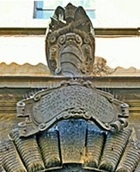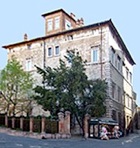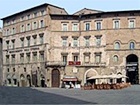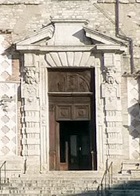

Ludovico Scalza (Vico di Meo), who was born in Orvieto, was the cousin of the more famous Ippolito Scalza. Like his cousin, he was first documented in 1555, when he was at work on the figures of prophets on the facade of the Duomo (see below).
Most of the surviving known works by Ludovico Scalza are in Perugia, the city to which he rented a house in 1567.
Orvieto
Prophets (1555-6)
A team under Francesco Mosca, il Moschino worked on the series of figures of prophets for the niches that flank the rose window on the facade of the Duomo. The sculptors mentioned included Ludovico and Ippolito Scalza (above).
Arms of Pope Pius V (1571)

Perugia
Cappella della Corgna (1555-62)
Cardinal Ascanio della Corgna commissioned the “Giovanni di Domenico Fiorentino” (who has been identified as Giovanni di Domenico Caffarelli da Settignano) to build an altar in his family chapel in San Francesco al Prato (on the left wall of the right transept), following a design by Giacomo Barozzi da Vignola. Two years later, Giacomo della Corgna commissioned its decoration by Giovanni Battista Ingoni, in a contract that specified that Vignola would assess the work and set the price. Giorgio Vasari reported that Ingoni executed “many pictures of the life of St Andrew [to whom the chapel was dedicated], in which he acquitted himself very well”.
Other artists who worked on the chapel at this time include:
-
✴Ludovico Scalza, who executed its stucco decoration; and
-
✴Vincenzo Danti, who executed two statues, one of which portrayed St Andrew.
Much of this work was lost during the restoration of 1740-8, although some fresco fragments were detached in 1970 and moved to the sacristy.
Altare di San Bernardino (1559-67)
In 1559, the Collegio della Mercanzio commissioned Ludovico Scalza and and “Giovanni di Domenico Fiorentino” (who has been identified as Giovanni di Domenico Caffarelli da Settignano) to build a new altar in the Cappella di San Bernardino of the Duomo. It contained a number of works of sculpture that were attributed to Vincenzo Danti. Ottavio Lancellotti recorded in his “Scorta Sagra” (17th century) that this altar was finished in 1567. The altar was destroyed in 1797, and is now known only from a drawing (1793) that still belongs to the Collegio della Mercanzia.
Fragments in the Museo Capitolare that are attributed to Vincenzo Danti might have come from the decoration of this altar:
-
✴a mutilated head of the Risen Christ; and
-
✴a small head of the Virgin and three cherubs.
Work on the Baldeschi Palaces (1560-75)

.An inscription on its facade in Via Baldeschi records that Baldeschi built it in 1563: this date probably relates to the completion of the first floor of the wing of the palace that faces this street.

Door of the Duomo (1568)


